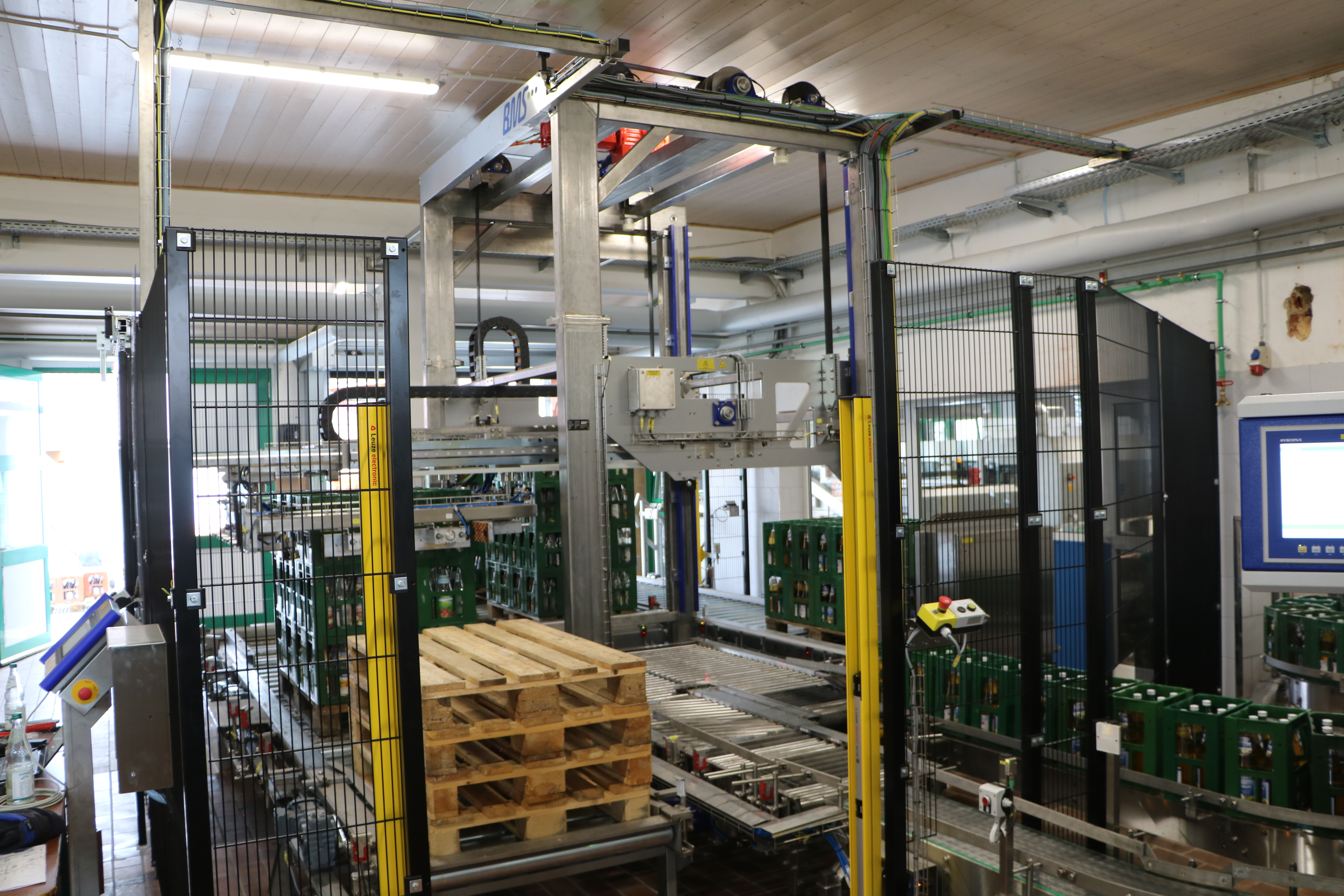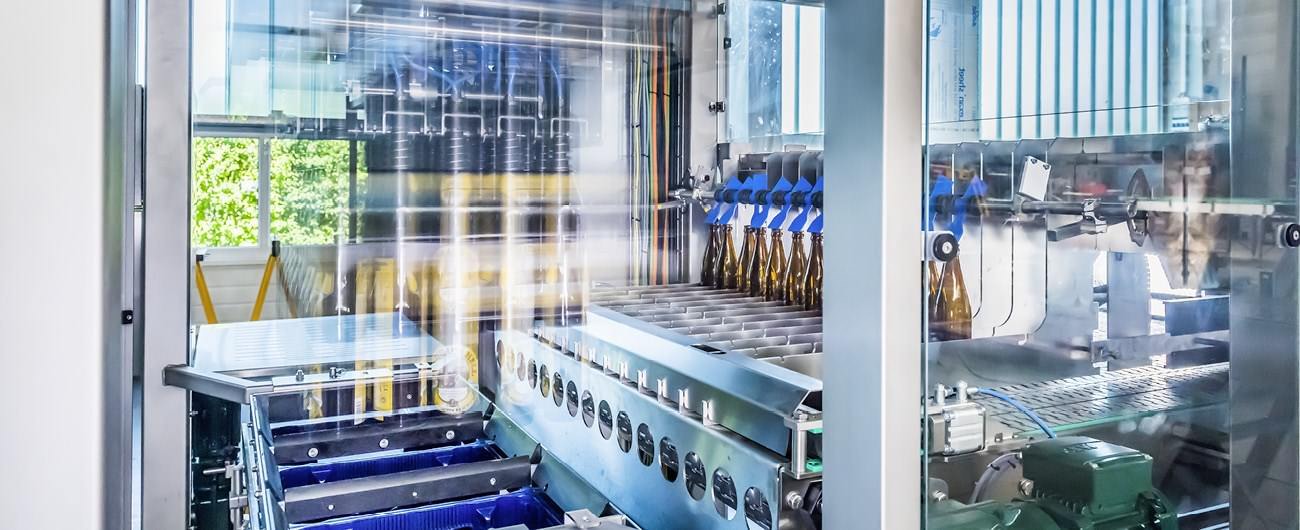Junginger Fruchtsäfte integrates palletiser from BMS
BMS Maschinenfabrik assists the Baden-Württemberg-based press house in the modernisation of its production plants.
Efficient processes are essential in order to focus fully on quality. In keeping with this principle, Junginger Fruchtsäfte GmbH & Co. KG decided to totally upgrade its palletiser system. There were, however, no conventional products offering a solution to this end, because the space available was too restricted.
As BMS Maschinenfabrik had already played a role in the renewal of the wet part in 2015, we were again chosen as a trusted partner in 2019. In close consultation with the Junginger family-run company we developed a prototype that ensures a fully automated process according to the exact specifications of the customer.
Read on to find out more about the task set by the press house, the solution that BMS presented and the challenges associated with this project.
 BMS Palletiser for Junginger.
BMS Palletiser for Junginger.
Designed for demanding requirements: Junginger Fruchtsäfte relies on BMS palletiser
The market environment of Junginger Fruchtsäfte GmbH & Co. KG, domiciled in the town of Niederstotzingen in Baden Württemberg, can be seen as extremely dynamic. Here tastes drive innovations in this segment, trends set the pace – this is where solutions are required to provide the needed production capacities when sales increase.
 Conversion of the sweep-off depalletiser to the combined loader and unloader Unipal 104
Conversion of the sweep-off depalletiser to the combined loader and unloader Unipal 104
The problem: Palletising at this brand manufacturer was based on a two decade-old crate palletiser for the full goods. This means that every crate is handled separately, there is no placing of complete layers. Also a member of staff is needed to feed in the complete volume of empties by hand. Obviously the cost and time involved are way out of proportion - not to mention the susceptibility to errors, which can lead to costly downtimes.
The solution: A palletiser system developed by BMS Maschinenfabrik and designed as a combined unit with extremely compact dimensions. The managers at Junginger Fruchtsäfte, Werner und Andreas Junginger, made a very deliberate decision in favour of our company. They had already been able to inspect BMS machines close up, in local breweries, and in 2015 we were significantly involved in the modernisation of the wet part of the filling line.
In the following you will find key specifications of the project, enabling you to gain a true insight into the day-to-day operation.
A short portrait: What Junginger Fruchtsäfte GmbH & Co. KG stands for
 Junginger Fruchtsäfte GmbH & Co. KG, domiciled in the town of Niederstotzingen
Junginger Fruchtsäfte GmbH & Co. KG, domiciled in the town of Niederstotzingen
High quality ingredients have been the basis of production for four generations already, creating quality “made in Niederstotzingen”. The press house, that originally started out as a cooperage, has focused on first-class fruit juices since 1959. The company is domiciled in the centre of the Ostalb – a region well known for its orchards. Here freshly picked fruit could be turned into musts by means of fermentation to make it keep longer.
An overview of major products of Junginger Fruchtsäfte GmbH & Co. KG:
- • Fruit juices
- • Fruit nectars
- • Carbonated spritzers
- • Musts
- • Cider
The special feature: To live up to its ambitious promise of quality at all times the family-run company Junginger relies on regional products. The raw materials as well as the preferred sales area are in the immediate vicinity and the products are sold in four company-owned beverage shops, among others. The rest of the sales is made over the counter at festivals, in selected culinary establishments and in regional food retail stores.
Palletising follows the already completed modernisation of the wet part (2015)
The consumer values high-quality products that stand out with their distinguished taste and are farmed regionally. In this respect, Junginger Fruchtsäfte GmbH & Co. KG is seen as the forerunner of the entire industry. To keep up this standard, ongoing modernisation of the plant in the Ostalb is common practice.
Let’s take a look back: Already in 2015 BMS was Junginger’s first choice for the complete modernisation of the wet part of the filling line, regarding both technical and structural aspects. Werner Junginger explains: “This led to a further quality enhancement. The oxygen input is now permanently lower and there are no more ruptures in the pasteuriser due to a bottle being overfilled.” Here BMS delivered two Unipack 2.0 packers that continue to perform reliably today.
The next step was to adapt the palletising using modern standards and to accommodate the changing market conditions. Besides the actual age of the plant (over 20 years) it was also the functioning mode “palletising of full crates” as well as the efficiency of the system that drove this decision.
 Werner (l.) and Andreas Junginger.
Werner (l.) and Andreas Junginger.
Turning Old into New: Transformation of the palletiser using BMS technology
Here a brief outline of the problems that arise during the daily operations:
- • Manual palletising is carried out by an employee, crate by crate
- • Limited space, this ruling out the possibility of a two-machine solution or a combi portal
- • Time and resource-consuming palletising and depalletising
In short:A new investment was required that,
- 1. complies with the available space conditions,
- 2. permits fully automatic palletising and depalletising and also
- 3. enables pick-up and placement of full pallets at the same gate by the forklift driver.
The problem: For a long time, Junginger Fruchtsäfte could not find a suitable product on the market that provided the required performance range (filler) and could carrying out both functions fully automatically. Andreas Junginger then contacted BMS and was presented an efficient solution in the form of the new glass sweep-off depalletiser Unipal 202 with level compensation.
Key basic data on the cooperation between Junginger Fruchtsäfte and BMS Maschinenfabrik:
- • Prototype development based on the new glass sweep-off depalletiser Unipal 202 (with level compensation)
- • Conversion of the sweep-off depalletiser to the combined loader and unloader Unipal 104
- • Inclusion of, among other things: Base frame, vertical and crosswise transfer unit (lifting axis and telescope), adjustment to higher palletising load level
- • New design of layer table (fitting the formation, release and gripper head of the crate layer and empty pallet)
- • Part of the order: Pallet pick-up and release at the forklift, conveyors for the full-goods and empties stream, integration of empties control as well as a high-speed gate
- • Machine footprint: 4,300 mm (L) x 2,400 mm (W), arrangement of layer table in the centre
Are you interested in more details? HERE you will find the full report including all major project specifications – take a look!
Published in: Getränke! Technologie & Marketing / September 2020





Select your language